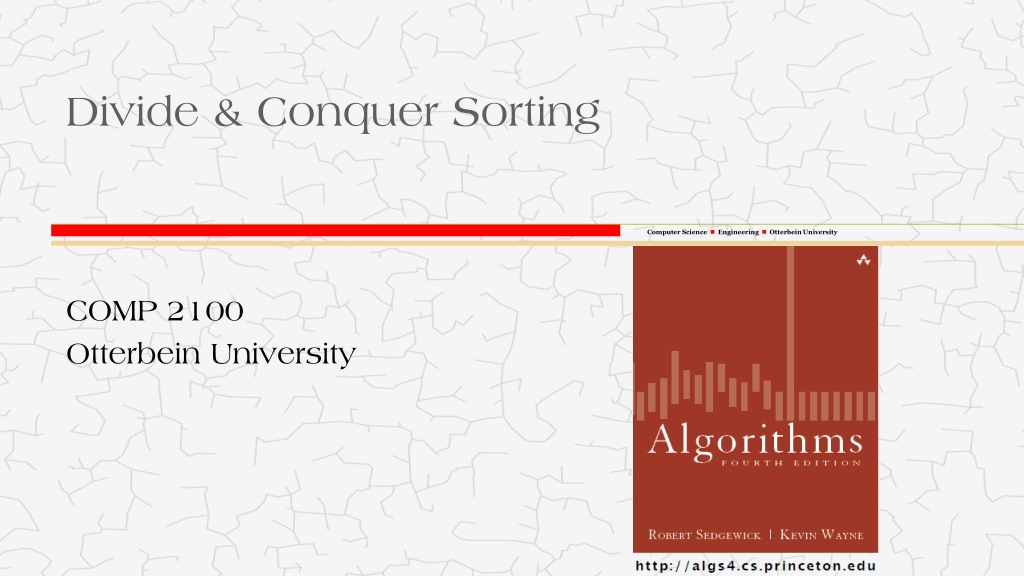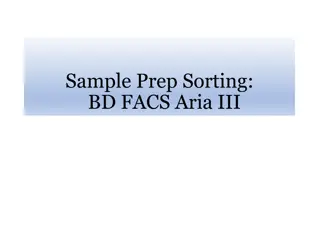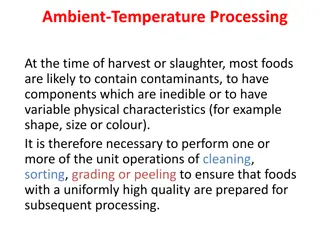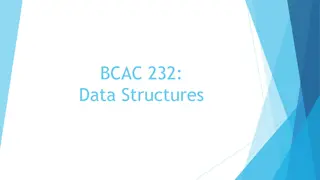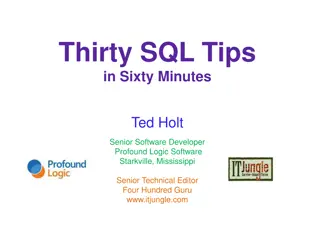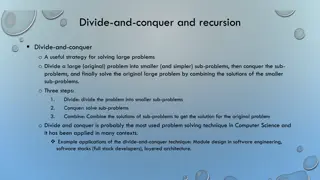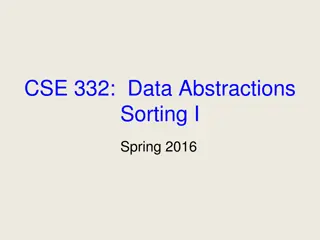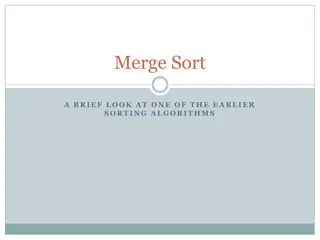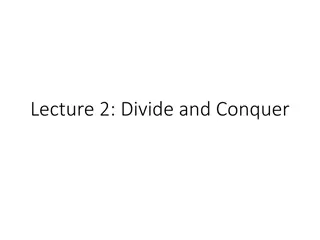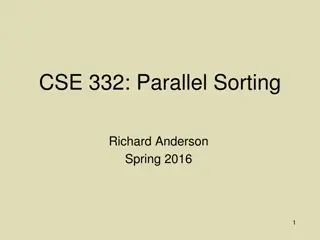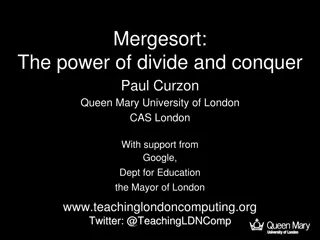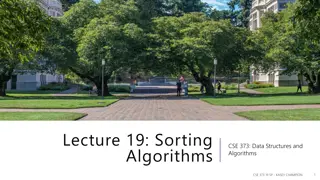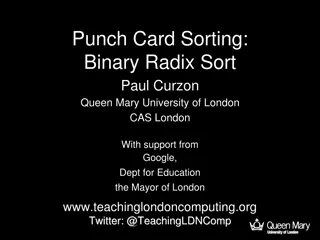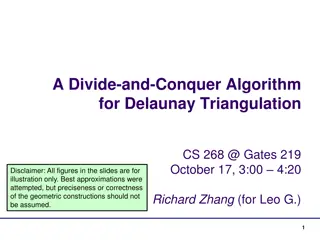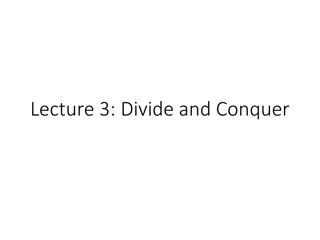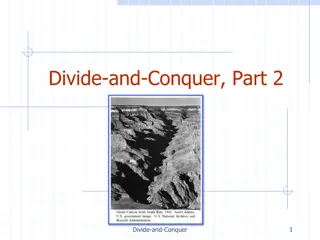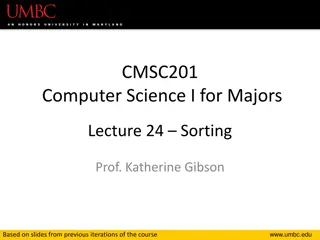Understanding Divide and Conquer Sorting at Otterbein University
Explore the concept of Divide and Conquer sorting in Computer Science at Otterbein University. Learn about the MergeSort and QuickSort algorithms, the design paradigm behind them, and steps involved in MergeSort. Discover how partitioning and merging play crucial roles in sorting sequences efficiently. Stay informed about upcoming homework and lab deadlines!
Download Presentation

Please find below an Image/Link to download the presentation.
The content on the website is provided AS IS for your information and personal use only. It may not be sold, licensed, or shared on other websites without obtaining consent from the author. Download presentation by click this link. If you encounter any issues during the download, it is possible that the publisher has removed the file from their server.
E N D
Presentation Transcript
Divide & Conquer Sorting Computer Science Engineering Otterbein University COMP 2100 Otterbein University
Alerts Computer Science Otterbein University Homework #7 due on Friday, 11/4 Lab 7 available next Tuesday This is the last lab for the semester! IT WILL TAKE ALL OF FOUR WEEKS TO COMPLETE!! (don't procrastinate...)
Divide & Conquer Computer Science Otterbein University Divide & conquer design paradigm Divide Divide: divide the input data S in two (or more) disjoint subsets S1and S2 Recur Recur: Solve the subproblems associated with S1and S2 Conquer Conquer: combine the solutions for S1and S2into a solution for S MergeSort and QuickSort are sorting algorithms based on divide & conquer MergeSort divides based on position QuickSort divides based on value Base case: directly solve and do not divide for small subproblem sizes (typically 0 or 1)
MergeSort (1945) Computer Science Otterbein University MergeSort on an input sequence S with n n elements consists of three steps: Divide: partition S into two sequences S1and S2of about n n/2 elements each Recur: recursively sort S1and S2 Conquer: merge S1and S2into a unique sorted sequence Algorithm Algorithm mergeSort (S) Input Input sequence S with n n elements Output Output sequence S sorted if if n n > 1 (S1, S2) partition (S, n n/2) S1 mergeSort (S1) S2 mergeSort (S2) S merge (S1, S2) return return S
Partitioning a Sequence Computer Science Otterbein University The divide step of mergeSort consists of partitioning input sequence S Use new arrays for the subsequences It is easy to see that partition takes O(n n) time Algorithm Algorithm partition (S, k) Input Input sequence S, with n n items; k, partition size Output Output partition of S into S1of size k and S2of size n n k S1 new array of size k S2 new array of size n n - k pos 0 for for i 0 to to k-1 do S1[i] S[pos++] for for i 0 to to n-k-1 do S2[i] S[pos++] return return (S1, S2) do do
Merging Two Sorted Sequences Computer Science Otterbein University The conquer step of mergeSort consists of merging two sorted sequences S1and S2 Algorithm Algorithm merge (S1, S2) Input Input sequences S1and S2, both sorted, with n n total items combined Output Output sorted sequence containing all the elements of S1and S2 Use new array for the merged sequence It is easy to see that partition takes O(n n) time S new array of size n n p length of S1; q length of S2 i 0; j 0; k 0 while while i < p and and j < q do if if S1[i] < S2[j] S[k++] S1[i++] else else S[k++] S2[j++] if if i =p copy S2[j..q-1] to S[k..p+q-1] else else copy S1[i..p-1] to S[k..p+q-1] return return S do
MergeSort in Action Computer Science Otterbein University Partition 7 2 9 4 | 3 8 6 1
MergeSort in Action Computer Science Otterbein University Recursive Call, Partition 7 2 9 4 | 3 8 6 1 7 2 | 9 4
MergeSort in Action Computer Science Otterbein University Recursive Call, Partition 7 2 9 4 | 3 8 6 1 7 2 | 9 4 7 | 2
MergeSort in Action Computer Science Otterbein University Recursive Call, Base Case 7 2 9 4 | 3 8 6 1 7 2 | 9 4 7 | 2 7 7
MergeSort in Action Computer Science Otterbein University Recursive Call, Base Case 7 2 9 4 | 3 8 6 1 7 2 | 9 4 7 | 2 7 7 2 2
MergeSort in Action Computer Science Otterbein University Merge 7 2 9 4 | 3 8 6 1 7 2 | 9 4 7|2 2 7 7 7 2 2
MergeSort in Action Computer Science Otterbein University Recursive Call, , Base Case, Merge 7 2 9 4 | 3 8 6 1 7 2 | 9 4 7|2 2 7 94 49 7 7 2 2 9 9 4 4
MergeSort in Action Computer Science Otterbein University Merge 7 2 9 4 | 3 8 6 1 7 2|9 4 2 4 7 9 7|2 2 7 94 49 7 7 2 2 9 9 4 4
MergeSort in Action Computer Science Otterbein University Recursive Call, , Merge, Merge 7 2 9 4 | 3 8 6 1 7 2|9 4 2 4 7 9 3 8 | 6 1 1 3 6 8 7|2 2 7 94 49 3 8 3 8 6 1 1 6 7 7 2 2 9 9 4 4 3 3 8 8 6 6 1 1
MergeSort in Action Computer Science Otterbein University Merge 7 2 9 4 | 3 8 6 1 1 2 3 4 6 7 8 9 7 2|9 4 2 4 7 9 3 8 | 6 1 1 3 6 8 7|2 2 7 94 49 3 8 3 8 6 1 1 6 7 7 2 2 9 9 4 4 3 3 8 8 6 6 1 1
MergeSort Analysis Computer Science Otterbein University Use recurrence relation. Algorithm Algorithm mergeSort (S) Input Input sequence S with n n elements Output Output sequence S sorted T(0) = T(1) = 2 T(n) = cn + T(n/2) + T(n/2) + cn = 2cn + 2T(n/2) where c is a constant if if n n > 1 (S1, S2) partition (S, n n/2) S1 mergeSort (S1) S2 mergeSort (S2) S merge (S1, S2) return return S Master Theorem: T(n) (n lg n)
Why is MergeSort (n lg n)? Computer Science Otterbein University The height of the mergeSort tree is O(lg n) because at each recursive call we divide the sequence in half The overall amount of work done at the nodes of depth i is O(n): partition, merge, and recursive calls Thus the total running time of mergeSort is O(n lg n) depth #calls size cost 0 1 n O(n) 1 2 n/2 O(n) i 2i n/2i O(n)
Practical Considerations Computer Science Otterbein University Mergesort s use of auxiliary arrays is expensive Implementing an in-place version can be tricky Mergesort has too much overhead for small arrays Solution: Cut-off the recursion early (~10 items) and use insertion sort for small blocks It is possible to short circuit the merge step if max(left) < min(right) Old versions of Java used this as the system sort for Object arrays (Now uses Timsort)
Summary so far... Computer Science Otterbein University
QuickSort (1959) Computer Science Otterbein University Select a partitioning element, p Rearrange the array such that element p is in its final position what is to the left of p is less than or equal to p what is to the right of p is greater than or equal to p Sort the left and right sub-arrays independently by recursion recursion
QuickSort Computer Science Otterbein University Divide: Select any element S[k] of the array to be the pivot Partition S into two sequences S1and S2, such that S[k] is relocated to its final position, S[i] j < i S[j] < S[i] j > i S[j] > S[i] Recur: recursively sort S1and S2 Conquer: trivial Algorithm Algorithm quickSort (S, i, j) Input Input sequence S; i and j, the upper and lower bound of sorting Output Output sequence S sorted from i to j if if j - i > 0 select pivot and move it to S[j] k partition (S, i, j) quickSort (S1, i, k-1) quickSort (S2 , k+1, j) k i
Selecting the Pivot Computer Science Otterbein University Fixed element Right-most Left-most Center Median Random Median of 3 (right, left, center)
QuickSort Partition Computer Science Otterbein University QuickSort s partition is performed in place Scan from ends towards center looking for pairs of elements out of order to be exchanged It is easy to see that partition takes O(n n) time Algorithm Algorithm partition (S, i, j) Input Input sequence S, with pivot at S[j]; i and j, the upper and lower bound of sorting Output Output S with elements rearranged so elements smaller than pivot are to its left & those larger to it right; returns final index of pivot p S[j] u i; v j-1 while while u < v do do while while S[u] < p do do u++ while while S[v] > p do do v swap (S, u, v) swap (S, u, j) return return u
QuickSort in Action Computer Science Otterbein University 3 72 1 5 47 34 20 10 9 23 u v
QuickSort in Action Computer Science Otterbein University 3 72 1 5 47 34 20 10 9 23 u v
QuickSort in Action Computer Science Otterbein University 3 9 1 5 47 34 20 10 72 23 u v
QuickSort in Action Computer Science Otterbein University 3 9 1 5 10 34 20 47 72 23 u v
QuickSort in Action Computer Science Otterbein University 3 9 1 5 10 20 34 47 72 23 u v
QuickSort in Action Computer Science Otterbein University 3 9 1 5 10 20 23 47 72 34 v u
QuickSort is not stable Computer Science Otterbein University 6 8 5 2 7 1 2 3 2 1 2 3 7 8 6 5
QuickSort Analysis Computer Science Otterbein University T(n) = n + T(p 1) + T(n p) If pivot always lands in the middle, this yields T(n) 2T(n/2) + n Algorithm Algorithm quickSort (S, i, j) Input Input sequence S; i and j, the upper and lower bound of sorting Output Output sequence S sorted from i to j if if j - i > 0 select pivot and move it to S[j] p partition (S, i, j) quickSort (S1, i, p-1) quickSort (S2 , p+1, j) Thus, T(n) (n lg n) If pivot always lands at the end, we get T(n) = n + T(n 1) Best case: (n lg n) Here, T(n) (n2) Worst case: (n2)
Average Case Analysis Computer Science Otterbein University It turns out, as we will now prove, that QuickSort s average time complexity is (n log n) Warning: this derivation is long and complicated now may be a good time for a nap Z Z Z Z
Average Case Analysis Computer Science Otterbein University It is reasonable to assume that the pivot has equal probability (1/n) to land in each of the n possible positions. n 1 n = + + ( ) ( ( T p 1) ( )) T n n T n p a a a = 1 p n n Since we can simplify: = ( 1) ( ) T p T n p a a = = 1 1 p p 2 n n = + ( ) ( 1) T n n T p a a = 1 p
Average Case Analysis Computer Science Otterbein University 2 n n = + ( ) ( 1) T n n T p a a = 1 p Multiply by n n = + 2 ( ) 2 ( 1) nT n n T p a a = 1 p Substitute (n 1) for n 1 n = + 2 ( 1) ( T n 1) ( 1) 2 ( 1) n n T p a a = 1 p Subtract last two equations ???(?) (? 1)??(? 1) = ?2 (? 1)2+ 2??(? 1) Simplify = + 1) 2 + ( ) ( 1) ( T n 1 nT n n n a a
Average Case Analysis Computer Science Otterbein University = + 1) 2 + ( ) ( 1) ( T n 1 nT n n n a a Divide by n(n+1) ( ) + ( 1) T n n T n 2 + 1 = + a a + 1 1 ( 1) n n n n Drop small term, creating inequality ( ) + ( 1) T n n T n 2 + + a a 1 1 n n Define F(n) = Ta(n)/(n+1) and substitute 2 n + ( ) ( 1) F n F n
Average Case Analysis Computer Science Otterbein University 2 n + ( ) ( 1) F n F n Expand 2 2 n + + ( ) ( 2) F n F n 1 n Expand completely into a sum 1 2 1 3 1 1 n + + + + + ( ) 2 1 (log ) F n n 1 n Remember that F(n) = Ta(n)/(n+1), so WAKE UP!! ( log ) n ( ) a T n n
For more information... Computer Science Otterbein University This was a very fast overview/review of these two sorting algorithms Sections 2.2 & 2.3 are a treasure trove of good, solid reasoning about mergesort and quicksort variations and tweaks: definitely worthwhile reading!
